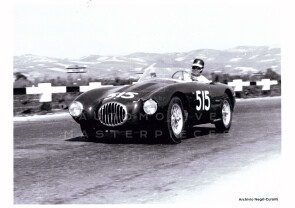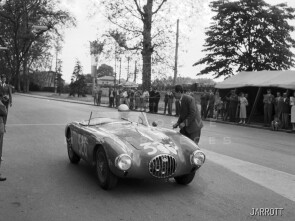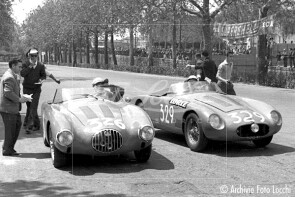
1955 O.S.C.A. MT4-2AD 1100
ON/OFF
Why am I an Automotive Masterpiece?
L. Limited edition cars
no. 80 manufactured. No. 80 manufactured
In 1937 the three surviving Maserati brothers, Ettore, Ernesto and Bindo, sold out to the Orsi Group in Modena to avoid bankruptcy. The assignment contract included a ten-year consultancy for the Maserati brothers. After that period, in 1947, they decided to come back to San Lazzaro di Savena, near Bologna and found the Officine Specializzate per la Costruzione Automobili Fratelli Maserati S.p.A. – O.S.C.A. for short – to build limited edition competition cars. The Maserati brothers were real racers, and their little O.S.C.A.s built, were real racing cars, the ultimate expressions of a long line of outstanding cars that bore their name, beginning in 1926. O.S.C.A.'s first automobile was the MT4, for Maserati Tipo 4 cilindri. Their goal was to develop an automobile to compete in the 1100 cc racing class. The choice of a small displacement was due to financial reasons: two years after World War II, Italy was still economically prostrate, moreover, there were no sponsors or big car manufacturers behind them to support the development of the car. There weren’t and won’t be teams of engineers or technicians in the years to come: Ernesto Maserati is solely responsible for conception and design. Over the next eight years the MT4 was developed into the most successful under-1500 cc sports/racing car in the world. The chassis followed the lines of their A6GCS Maserati (the last model they designed before leaving the Maserati factory): a tubular frame with independent double A-arms front suspension and a live axle on the back. The 1092 cc engine had an alloy headed FIAT-derived block and the bodywork was built as a two-seater barchetta. Tested by the same Ernesto, the car made its racing debut in September 1948 driven by Gigi Villoresi who, against racers and cars of the highest level brought the small O.S.C.A. to victory. A young Veronese, Giulio Cabianca, bought an OSCA 1100. He began a very long series of successes and, then, more and more drivers will be driving an Osca. The brothers continuously developed the engine and created (for the MT4-2AD) their own aluminum-block engine design with twin cams and cc started to grow, from 1342 cc, to 1453 cc and then, finally, to the twin-spark 1491 cc variant. O.S.C.A. fit seven different versions of their alloy Inline-4 engine into the MT4, and all fell below the 1.5 liter mark. Of the around 200 O.S.C.A. cars produced, perhaps 80 were MT4s, and of the MT4s, records show 40 barchettas with Morelli of Ferrara bodies. There were other interpretations, of course, like the coupes of Vignale or Frua. But the most interesting aspect is that many MT4 were updated in the body with the years, even by artisans, to be always competitive in the races in which they participated. The MT4 was OSCA's most prolific model, but the company also produced a variety of models in both single and two-seater configuration fitted with four, six, and even twelve-cylinder engines, from 750 cc to 4500 cc.
The O.S.C.A. MT4-2AD from 1955 with chassis 1162 is an example bodied by the Fratelli Morelli. The car raced the Mille Miglia three times with its first owner, the driver Carlo Falli. The first time, in 1955, with number 515, despite being in an excellent position, it was forced to withdraw after Rome. The second time, in 1956, with race number 406, it finished 124th overall and 3rd in its class (Sport 1100). The third time, it raced in 1957 with race number 326, finishing 62nd overall and, again, 3rd in class. There is news of the car competing in other races as well, always with Carlo Falli at the wheel. In 1956 at the Gran Premio Pietro Cidonio - Circuito di Collemaggio (6th in class); at the Coppa Spoleto - Monteluco (3rd in class); finally at the Gran Premio Roma - 6 ore di Castelfusano (10th in class). In 1958 the car ran the Circuito di Caserta and the Coppa del Gran Sasso; in both placing 3rd in class. There is no news of the car until 1970, when it arrived in the United States, probably equipped with an engine that is no longer original and received in 1972 yet another engine, the n° 1523. It was restored and painted in the colors (blue, red and yellow) of the "A.S.K. Enterprises" team, which also owns another example of O.S.C.A. MT4-2AD (chassis no. 1167). The car chassis 1162 was for Anthony Koshland and Judy Stropus, Penske team timekeeper. The car was later put on sale in 1974 and changed owners again in 1979, 1985 and 1987, when it was acquired by Peter Kaus' Rosso Bianco Collection. The Collection exhibits it at Rétromobile in 2003. The year in which it is sold and, finally, it recovers its original no. 1130 engine. Since 2009 it belongs to the current owner.






